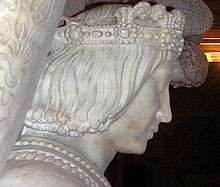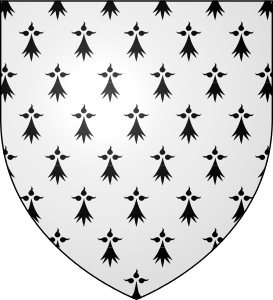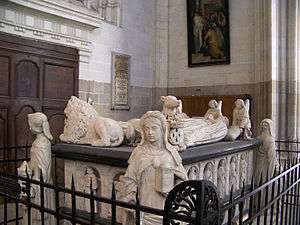Francis II, Duke of Brittany
| Francis II | |
|---|---|
 Sculpture of Francis II on his Tomb in Nantes. | |
| Duke of Brittany | |
| Reign | 26 December 1458 – 9 September 1488 |
| Coronation | 3 February 1459 |
| Predecessor | Arthur III |
| Successor | Anne |
| Born |
23 June 1433 Château de Clisson, Clisson |
| Died |
9 September 1488 (aged 55) Couëron |
| Burial | Nantes Cathedral |
| Consort |
Margaret of Brittany Margaret of Foix |
| Issue |
John, Count of Montfort Anne of Brittany Isabeau of Brittany |
| House | House of Dreux-Montfort |
| Father | Richard, Count of Étampes |
| Mother | Marguerite d'Orléans |
| Religion | Roman Catholicism |

Francis II of Brittany (in Breton Frañsez II, in French François II) (23 June 1433 – 9 September 1488) was Duke of Brittany from 1458 to his death. He was the son of Richard of Brittany and the grandson of Duke John IV. A recurring theme in Francis' life would be his quest to maintain the quasi-independence of Brittany from France. As such, his reign was characterised by conflicts with King Louis XI of France and with his daughter, Anne of France, who served as regent during the minority of her brother, Charles VIII. The armed and unarmed conflicts between 1484-1488 have been called the Mad War (la Guerre Folle) and also the War of the Public Weal.
Biography
Early life
Francis II was born on 23 June 1433 to Richard, Count of Étampes and his wife Marguerite d'Orléans. Richard was the youngest son of John IV, Duke of Brittany. Richard's older brothers John and Arthur both succeeded their father as duke, but upon Arthur's death in 1458, the only legitimate male heir was his nephew, Francis.
Relationship with English royalty
Protector of the House of Lancaster
Francis II serendipitously became the protector of England's House of Lancaster in exile from 1471-1484.
During the latter half of the 15th century, civil war existed in England as the Houses of York and Lancaster fought each other for the English throne. In 1471, the Yorkists defeated their rivals in the battles of Barnet and Tewkesbury. The Lancastrian King Henry VI and his only son, Edward of Lancaster, died in the aftermath of the Battle of Tewkesbury. Their deaths left the House of Lancaster with no direct claimants to the throne. The Yorkist king, Edward IV, was in complete control of England.[1] He attainted those who refused to submit to his rule, such as Jasper Tudor and his nephew Henry, naming them as traitors and confiscating their lands.
The Tudors tried to flee to France but strong winds forced them to land in the Duchy of Brittany, where they were taken into the custody of Francis II.[2] Henry Tudor, the only remaining Lancastrian noble with a trace of royal bloodline, had a weak claim to the throne,[1] and Edward regarded him as "a nobody."[3] Francis II, however, viewed Henry as a valuable tool to bargain for England's aid in conflicts with France and therefore kept the Tudors under his protection.[3]
In October 1483, Henry launched a failed invasion of England from Brittany. His fleet of 15 chartered vessels was scattered by a storm, and his ship reached the coast of England in company with only one other vessel. Henry realized that the soldiers on shore were Richard III's men, and so he decided to abandon the invasion and return to Brittany. The Duke of Buckingham, who was Henry's main conspirator in England, was convicted of treason and beheaded in Salisbury on 2 November 1483, in fact before Henry's ships made landfall.[4] Henry's conspiracy against Richard III had unravelled, and without Buckingham or Henry, the rebellion was easily crushed.[5]
Survivors of the failed uprising then fled to Brittany, where they openly supported Henry's claim to the throne.[6] On Christmas Day in 1483 at Rennes Cathedral, Henry Tudor swore an oath to marry Edward IV's daughter, Elizabeth of York, and thus unite the warring houses of York and Lancaster.[7] Henry's rising prominence made him a great threat to Richard III, and the Yorkist king made several overtures to Francis II to surrender the young Lancastrian. Francis II refused, holding out for the possibility of better terms from Richard.[8] In mid-1484, Francis was incapacitated by illness and while recuperating, his treasurer, Pierre Landais, took over the reins of government. Landais reached an agreement with Richard III to send Henry and his uncle back to England in exchange for military and financial aid. John Morton, a bishop of Flanders, learned of the scheme and warned the Tudors; the Tudors then fled to France.[9] The French court allowed them to stay and provided resources.[10] For the French, the Tudors were useful pawns to ensure that Richard's England did not interfere with French plans to annex Brittany.[11] Thus the loss of the Lancastrians seriously played against the interests of Francis II.[lower-alpha 1]
Titular Earl of Richmond
Circa 1136, King Stephen of England named Alan of Penthièvre of Brittany (also known as Alan the Black) the 1st Earl of Richmond. After Alan, the title and its possessions (the Honour of Richmond) were typically bestowed upon the Dukes of Brittany, with a few interruptions, through the ducal reign of John V, which ended in 1399. After John V, the English kings would bestow the title Earl of Richmond on nobles other than the Dukes of Brittany, including Edmund Tudor, Henry Tudor's father. However the dukes of Brittany from John VI through Francis II would continue to use the titulary Earl of Richmond. It is possible that Francis willed whatever remained of his claims to the earldom and the Honour of Richmond to Henry Tudor. On successfully gaining the English crown after the Battle of Bosworth Field in 1485, Henry VII merged the earldom and its possessions into the crown.[lower-alpha 2]
Relationship with French royalty
King Louis XI
Louis XI was renowned as a cunning adversary and a master at diplomacy, if not the military arts. His contemporary nickname was "The Universal Spider," reflecting his constant political plotting.
Francis II became a member of the League of the Public Weal.[lower-alpha 3] This was an alliance of feudal nobles organized in 1465 in defiance of the centralized authority of King Louis XI of France, whose declared aim was to enlarge the French royal domain by annexing all of the duchies – Burgundy, Berry, Normandy, Orléans, Brittany, etc. It was masterminded by Charles the Bold, Count of Charolais, son of the Duke of Burgundy, with the king's brother Charles, Duke of Berry, as a figurehead.
In 1467 Charles the Bold inherited the Duchy of Burgundy, which held fiefs in France that included the counties of Artois and Flanders, and the Imperial lands of Holland, Brabant, and Luxembourg. As Duke of Burgundy, Charles aspired to forge a kingdom of his own between France and Germany, approximating the former domains of the Frankish Emperor Lothair I. In pursuit of this goal, Charles was killed in 1477 at the Battle of Nancy against René II, Duke of Lorraine and a hired army of Swiss mercenaries, and Louis was saved from his greatest adversary. The great Duchy of Burgundy was then absorbed into the Kingdom of France, and the League of the Public Weal was essentially defeated, although several members would re-ally for the Mad War in 1485.
The fortunes of Francis II and Brittany would continue to suffer after Louis XI's death in 1483, as Louis' daughter Anne of France would serve as regent for his successor, Charles VIII.
Regency of Anne of France
Francis II was anxious to maintain his duchy's autonomy during the minority of Charles VIII of France. He aligned himself with Louis, the Duke of Orléans (the future Louis XII) and Charles, Count of Angoulême, against the regency of Anne of France. Anne had been pursuing the same underhand politics as her father, Louis XI, towards Brittany.
In focusing on relations with his neighbour France, however, Francis II neglected his own realm. His corrupt and oppressive prime minister, Guillaume Chauvin, was overthrown by treasurer general Pierre Landais in 1477. A large part of the nobility had been bribed by Anne and Charles and supported them in their eagerness to subjugate Brittany. These nobles performed a coup d'état against Landais, who was eventually hanged in 1485.
In 1486, the Estates of Brittany confirmed the succession of Brittany on Francis' daughter Anne, to further assure the Duchy's autonomy from France. The Treaty of Chateaubriant was signed with France in 1487 and reaffirmed Brittany's autonomy. Despite the Treaty of Chateaubriant, however, the French continued to harass the Duchy. Under the leadership of Louis II de la Trémoille, the French royal army struck against Vannes and Fougères, controlling access to Brittany.
La Guerre Folle (The Mad War)
Francis II then allied with Maximilian I, Holy Roman Emperor, against France. Alain d'Albret, a rebel lord, believing he would marry Francis' daughter Anne, reinforced the Breton army with 5000 troops supplied by the king of Spain. Maximilian I of Austria also sent 1500 men, and Edward Woodville, Lord Scales, brought over a force of archers from Britain.[17] However Brittany was defeated 28 July 1488 in the Battle of Saint-Aubin-du-Cormier. This battle also destroyed the power-base of the warring noble leaders as Edward Woodville was killed, and Louis of Orléans and Jean, Prince of Orange were captured. Alain d'Albret and the Maréchal de Rieux succeeded in escaping, and played an important part in continuing the conflict.
A few days later, on 10 August, Francis was forced to sign the Treaty of Verger. Under the terms of the treaty, the duke was compelled to submit himself and his duchy as a vassal of the king of France, and to expel foreign princes and troops from Brittany. It also restricted his ability to marry his children to suitors of his choosing and required that he cede territory in Saint-Malo, Fougères, Dinan, and Saint-Aubin to the king as a guarantee that in the absence of a male successor the king would determine the succession. Francis died a few months later as a result of a fall from his horse during a leisurely ride. He left only a daughter, Anne of Brittany, so the treaty was used to force her, as his successor, to marry Charles VIII, and later Louis XII. Despite the French victory and the signing of the treaty, la Guerre Folle dragged on beyond Francis II's death for three more years until December 1491, when Anne married Charles VIII.
Francis II is interred in an elaborate tomb in the Nantes Cathedral. His tomb was commissioned by his daughter Anne, and is an important early example of Renaissance sculpture in France.[lower-alpha 4]

Family
Francis II was married twice.
His first wife was his cousin Margaret of Brittany, the first daughter of Duke Francis I. They had one son who died shortly after his birth:
- John (29 June- 25 August 1463), Count of Montfort
His second wife was Margaret of Foix, Princess of Navarre. They had two children:
- Anne of Brittany (1477-1514) - his only legitimate heir to reach adulthood,
- Isabeau of Brittany (1478–1490), betrothed to Jean d'Albret in 1481, died young and buried in the Rennes Cathedral.
Francis II also had several illegitimate children with Antoinette de Maignelais, the former mistress of Charles VII of France.
Legacy
Breton nobles acted to safeguard Anne as their Duchess and to protect the Duchy's autonomy for which Francis had fought so hard. In 1489 these nobles signed the Treaty of Redon with Henry VII; that treaty between Brittany and England was intended to prevent the annexation of Brittany by France. However, in 1491 Charles VIII of France invaded Brittany and forced Anne to marry him, thereby gaining control of the duchy. Then in 1492 Henry VII signed the Treaty of Etaples with France, effectively removing England's defense of Breton autonomy in return for promises from the French to no longer support Perkin Warbeck, pretender to the English throne, and to pay a war indemnity. The duchy's autonomy was all but lost as the process of merging it into the French crown began, and Brittany's strongest ally was neutralized. Anne, however, would become a formidable Queen Consort and would fight to preserve Brittany's autonomy and Francis II's legacy for herself, the Breton people, and her descendants.
Ancestry
| Ancestors of Francis II, Duke of Brittany | ||||||||||||||||||||||||||||||||||||||||||||||||||||||||||||||||||||||||||||||||||||||||||||||||||||||||||||||||||||||||||||||||||||||||||||||||||||||||||||||||||||||||||||||||||||||||||||||||||||||||||||||||||||||||||||||||||||||||||||||||||||||||||||||||||||||||||||||||||||||||||||||||||||||||||||||||||||||||||||||||||||||||||||||||||||||||||||||||||||||||||||||||||||||||||||||||||||||||||||||||||||||||||||||||||||||||||||||||||||||||||||||||||||||||||||||||||||||||||||||||||||||||||||||||||||||||||||||||||
|---|---|---|---|---|---|---|---|---|---|---|---|---|---|---|---|---|---|---|---|---|---|---|---|---|---|---|---|---|---|---|---|---|---|---|---|---|---|---|---|---|---|---|---|---|---|---|---|---|---|---|---|---|---|---|---|---|---|---|---|---|---|---|---|---|---|---|---|---|---|---|---|---|---|---|---|---|---|---|---|---|---|---|---|---|---|---|---|---|---|---|---|---|---|---|---|---|---|---|---|---|---|---|---|---|---|---|---|---|---|---|---|---|---|---|---|---|---|---|---|---|---|---|---|---|---|---|---|---|---|---|---|---|---|---|---|---|---|---|---|---|---|---|---|---|---|---|---|---|---|---|---|---|---|---|---|---|---|---|---|---|---|---|---|---|---|---|---|---|---|---|---|---|---|---|---|---|---|---|---|---|---|---|---|---|---|---|---|---|---|---|---|---|---|---|---|---|---|---|---|---|---|---|---|---|---|---|---|---|---|---|---|---|---|---|---|---|---|---|---|---|---|---|---|---|---|---|---|---|---|---|---|---|---|---|---|---|---|---|---|---|---|---|---|---|---|---|---|---|---|---|---|---|---|---|---|---|---|---|---|---|---|---|---|---|---|---|---|---|---|---|---|---|---|---|---|---|---|---|---|---|---|---|---|---|---|---|---|---|---|---|---|---|---|---|---|---|---|---|---|---|---|---|---|---|---|---|---|---|---|---|---|---|---|---|---|---|---|---|---|---|---|---|---|---|---|---|---|---|---|---|---|---|---|---|---|---|---|---|---|---|---|---|---|---|---|---|---|---|---|---|---|---|---|---|---|---|---|---|---|---|---|---|---|---|---|---|---|---|---|---|---|---|---|---|---|---|---|---|---|---|---|---|---|---|---|---|---|---|---|---|---|---|---|---|---|---|---|---|---|---|---|---|---|---|---|---|---|---|---|---|---|---|---|---|---|---|---|---|---|---|---|---|---|---|---|---|---|---|---|---|---|---|---|---|---|---|---|---|---|---|---|---|---|---|---|---|---|---|---|---|---|---|---|---|---|---|---|---|---|---|---|---|---|---|---|---|---|---|---|---|---|---|---|---|---|---|---|---|---|---|---|---|---|---|---|---|---|---|---|---|---|---|---|---|---|---|---|---|---|---|---|---|---|---|---|---|---|---|---|---|---|---|---|---|
| ||||||||||||||||||||||||||||||||||||||||||||||||||||||||||||||||||||||||||||||||||||||||||||||||||||||||||||||||||||||||||||||||||||||||||||||||||||||||||||||||||||||||||||||||||||||||||||||||||||||||||||||||||||||||||||||||||||||||||||||||||||||||||||||||||||||||||||||||||||||||||||||||||||||||||||||||||||||||||||||||||||||||||||||||||||||||||||||||||||||||||||||||||||||||||||||||||||||||||||||||||||||||||||||||||||||||||||||||||||||||||||||||||||||||||||||||||||||||||||||||||||||||||||||||||||||||||||||||||
Notes
- ↑ On 16 March 1485, Richard's queen, Anne Neville, died,[12] and rumours spread across the country that she was murdered to pave the way for Richard to marry his niece, Elizabeth. The gossip alienated Richard from some of his northern supporters,[13] and upset Henry across the English Channel.[14] The loss of Elizabeth's hand in marriage could unravel the alliance between Henry's supporters who were Lancastrians and those who were loyalists to Edward IV.[15] Anxious to secure his bride, Henry assembled approximately 2,000 men and set sail from France on 1 August.[16] Henry's second successful invasion of England ended with his victory at the Battle of Bosworth Field.
- ↑ History has shown that those with conflicting claims to titles can work as temporary allies, such as the many cooperations between monarchs of England and France, despite their many wars.
- ↑ League of the Public Weal in French is La ligue du Bien public
- ↑ Francis II's tomb was designed by Jean Perréal and sculpted by Michel Colombe.
See also
- Dukes of Brittany family tree
- Henry VII of England
- War of the Roses
- Other politically important horse accidents
References
- 1 2 Ross 1997, pp. 172–173.
- ↑ Chrimes 1999, p. 17.
- 1 2 Ross 1999, p. 192.
- ↑ Williams, p. 25.
- ↑ Ross 1999, p. 117.
- ↑ Ross 1999, p. 118.
- ↑ Ross 1999, p. 196.
- ↑ Chrimes 1999, p. 19.
- ↑ Lander 1981, p. 324.
- ↑ Kendall, p. 297.
- ↑ Chrimes 1999, p. 31.
- ↑ Ross 1999, p. 144.
- ↑ Ross 1999, pp. 145–146.
- ↑ Chrimes 1999, p. 38.
- ↑ Chrimes 1999, p. 39.
- ↑ Lander 1981, p. 325.
- ↑ Currin, p. 379-412.
Bibliography
- Adams, George (1896). The Growth of the French Nation. Chautauqua Century Press.
- Currin, John M. (2000). "The King's Army into the Partes of Bretaigne': Henry VII and the Breton Wars", War in History, Vol. 7, No. 4.
- Contamine, Philippe (2004). 'Bataille de Saint-Aubin-du-Cormier, in Jacques Garnier dir. Dictionnaire Perrin des guerres et batailles de l'histoire de France. Paris,France: Perrin.
- Chrimes, Stanley (1999) [1972]. Henry VII. Yale English Monarchs. New Haven, Connecticut; and London: Yale University Press. ISBN 0-300-07883-8. Retrieved 20 April 2009.
- de La Borderie, Arthur Le Moyne (Membre de l'Institut) (1905–1914). Histoire de la Bretagne, 6 volumes in-quarto. Rennes, France: Imprimerie Vatar, Plihon Editeur.
- Dupuy, Antoine (1880). Histoire de l'union de la Bretagne à la France, 2 vol. Paris,France: Librairie Hachette.
- Hoyt, Robert (1966). Europe in the Middle Ages. Harcourt, Brace and World, Inc., 2nd ed.
- Kendall, Paul Murray (1973). Richard the Third. Sphere Books. ISBN 0-351-17095-2.
- Kerhervé, Jean (1987). L'État Breton aux XIVe et XVe siècles, 2 vol. Maloine. ISBN 2-224-01703-0. Volume 2 ISBN 2-224-01704-9
- Lander, Jack (1981) [1980]. "Richard III". Government and Community: England, 1450–1509. Massachusetts, United States: Harvard University Press. ISBN 0-674-35794-9. Retrieved 26 May 2009.
- Legay, Jean-Pierre; Martin, Hervé (1982). Fastes et malheurs de la Bretagne ducale 1213-1532. Rennes, France: Editions *Ouest-France Université.
- Minois, Georges (1999). Anne de Bretagne. Paris, France: Fayard.
- Ross, Charles (1997) [1974]. Edward IV. Yale English Monarchs (revised ed.). New Haven, Connecticut; and London: Yale University Press. ISBN 0-300-07372-0. Retrieved 16 March 2009.
- Ross, Charles (1999) [1981]. Richard III. Yale English Monarchs. New Haven, Connecticut; and London: Yale University Press. ISBN 0-300-07979-6.
- Tourault, Philippe (1990). Anne de Bretagne. Paris, France: Perrin.
- L'État Breton, tome 2 de l' Histoire de la Bretagne et des pays celtiques. Morlaix: Éditions Skol Vreizh. 1996.
- Williams, Neville (1973). The Life and Times of Henry VII. London: Weidenfeld and Nicolson. ISBN 0-297-76517-5.
References
 This article incorporates text from a publication now in the public domain: Chisholm, Hugh, ed. (1911). "article name needed". Encyclopædia Britannica (11th ed.). Cambridge University Press.
This article incorporates text from a publication now in the public domain: Chisholm, Hugh, ed. (1911). "article name needed". Encyclopædia Britannica (11th ed.). Cambridge University Press.
| Francis II, Duke of Brittany Cadet branch of the House of Dreux Born: 23 June 1433 Died: 9 September 1488 | ||
| Regnal titles | ||
|---|---|---|
| Preceded by Arthur III |
Duke of Brittany Count of Montfort 1458–1488 |
Succeeded by Anne |
| Preceded by John II |
Count of Étampes 1465–1478 |
Succeeded by John III |
| Peerage of England | ||
| Preceded by Arthur III |
— TITULAR — Earl of Richmond 1458–1488 |
Succeeded by Anne |